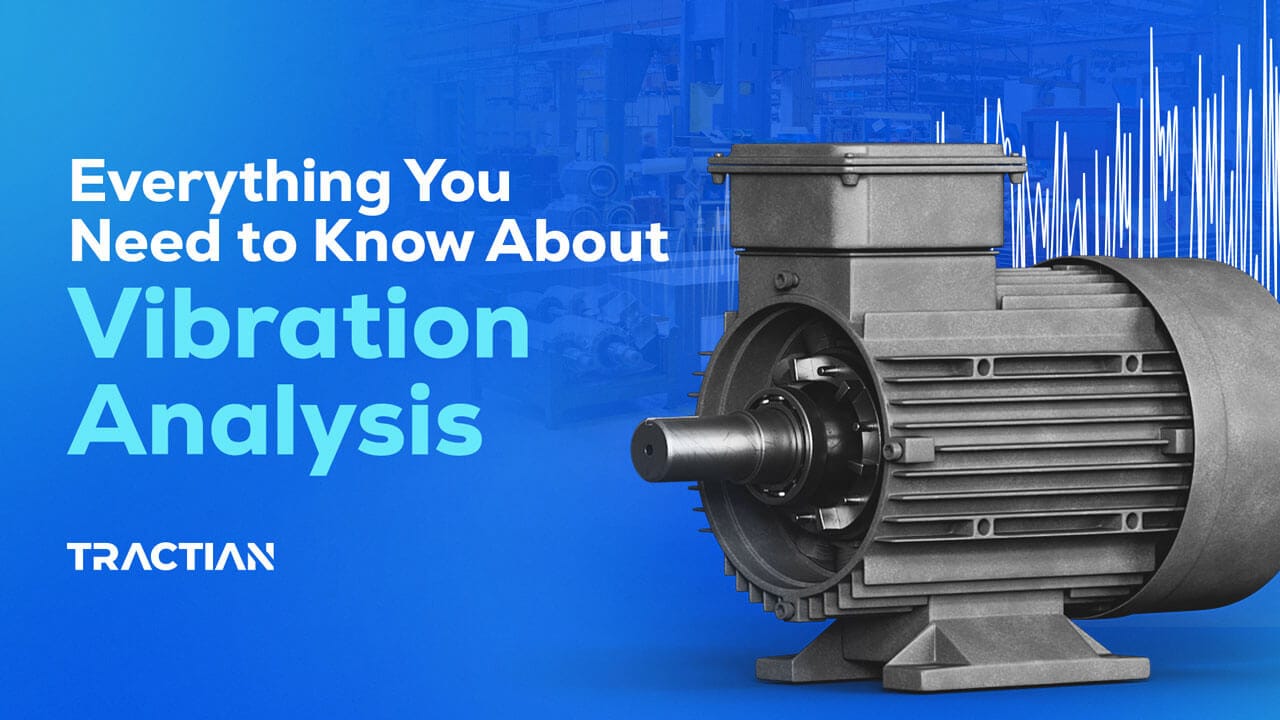The main goal of maintenance is simple: to improve performance and increase profits. In order to achieve these, teams must focus on tasks that increase asset reliability and availability – in turn reducing downtime.
One of the most efficient ways to do this is by monitoring machine conditions. Condition monitoring lets us assess each asset, giving us crucial information about their behavior and current condition.
The most common and efficient monitoring technique is vibration analysis (VA). It’s often used to identify early signs of wear rotating equipment, as well as predict possible faults and failures. By monitoring vibration levels over time, engineers can see if a machine is starting to show signs of trouble. This allows them to take action before a failure occurs, preventing costly downtime and damage.
What Is Vibration Analysis?
Vibration analysis it’s often used to identify early signs of wear rotating equipment, as well as predict possible faults and failures.
But why do technicians and industries perform vibration analysis?
Simple: by monitoring vibration levels over time, engineers can see if a machine is starting to show signs of trouble. This allows them to take action before a failure occurs, preventing costly downtime and damage.
How Does Vibration Analysis Detect Possible Failures?
As we learn about vibration monitoring, we must also understand how this data contributes to the prediction of asset failures.
All machines emit a vibration signature, or specific vibration profile when operating. With continuous monitoring and analysis, anomalies can be detected in the vibrations of that equipment and its components.
Maintainers verify if an unusual vibration pattern is related to a failure. Then, using spectrum analysis, we assess the anomalies, ensuring the machine’s health and proper functioning.
Here’s a visual example of spectral analysis:

Spectral or spectrum analysis is a way of breaking down a signal into its component frequencies. To do this we use the Fourier transform (FFT) to convert frequencies from the time domain to the frequency domain.
The frequency domain representation of a signal reveals the different frequencies that are present in the signal. This information can be used to identify different components of the signal, much like different harmonics in a machine vibration signal.
Important Vibration Parameters
Knowing how to understand a wave spectrum and its parameters is important for detecting failures.
To do this, we need to learn the specifications of each type of machine. We must consider its geometric characteristics and equipment behavior – like the number of motor poles and rotation speed. Motor X will be our example, with the following specifications.
MOTOR X
- Number of poles: 4
- Rotation 60Hz: 3,600 RPM
- Gear A: 36 teeth / Gear B: 72 teeth
- Maximum Temperature: 140 ºF

After learning a machine’s baseline behavior, we can start to identify patterns in the vibration diagrams. These patterns characterize problems related to anomalies in the asset. With this information we can build a base table to identify variations in vibration.

Other important parameters include acceleration, speed, and displacement.
Analyzing Acceleration, Speed, and Displacement
The three most common parameters used to measure and analyze vibration are acceleration, speed, and displacement.
Acceleration is the most sensitive parameter to changes in the condition of a machine. It’s often the best parameter to use for early detection of problems.
Speed is also a good parameter to use, as it can be used to identify resonance conditions.
Displacement is less sensitive to changes in the condition of a machine. It’s commonly used to measure the amplitude of vibration, which can be a sign of a loose or damaged component.
The best parameter to use depends on the specific application. Generally, you should measure all three parameters to get the most complete picture of the asset’s condition.

Types of Vibration Analysis Equipment
For vibration testing to be effective, we must accurately measure the vibration waves.
There are 4 general ways to measure these waves:
- Global level vibration meters – with or without a filter – measure the overall vibration level of a machine or structure. The filter is used to select the frequency range that you want to measure, making it easy to isolate specific problems.
- Accelerometers measure the acceleration of a vibrating object. By measuring the acceleration, you can get an estimate of the vibration’s amplitude and frequency.
- Velocity sensors measure the amplitude, frequency, and velocity of a vibrating object. Measuring the velocity gives you an estimate of the vibration’s amplitude and frequency.
- Displacement sensors measure the displacement of a vibrating object. This measurement gives you an estimate of the vibration’s amplitude.

The method you choose will depend on the specific application. If you need to measure the frequency of vibration, then an accelerometer or velocity sensor would be a good choice. If you need to measure the displacement of vibration, then a displacement sensor would be a good choice.
Good news is: you can apply this technique in a wide array of assets, like motors, bearings, gearboxes, rotors and so on.
Key Considerations in Vibration Analysis
When conducting vibration analysis, it’s crucial to focus on these key aspects:
Steady-State and Transient Signals
Grasping the nature of vibration signals is essential. Steady-state signals are continuous and repetitive, whereas transient signals occur due to specific events, providing critical diagnostic information.
Synchronous Peaks
Synchronous peaks appear at the shaft’s fundamental rotation frequency and its harmonics (e.g., 2X, 3X). These peaks reflect the normal operation of rotating machinery and help identify regular operational patterns.
Asynchronous Peaks
Asynchronous peaks do not align with the shaft rotation frequency. They often indicate irregularities such as gearbox issues, pump cavitation, or periodic impacts, making them valuable for diagnosing unexpected problems.
Sub-Synchronous Peaks
These peaks occur at frequencies lower than the fundamental rotation frequency. They can signify issues like slipping belts, bearing cage defects, or fluid flow turbulence, which are critical for detecting subtle mechanical problems.
Diagnostic Capabilities
Vibration analysis can uncover a range of mechanical issues, from misaligned components to structural weaknesses. It is particularly effective in verifying the proper installation of parts like bearings, ensuring they function correctly.
Advantages of Machine Vibration Analysis
Vibration analysis can help you predict when maintenance will be required, so you can avoid costly breakdowns and extend asset lifespan.
In addition to preventing breakdowns, vibration analysis can also help you improve plant efficiency, reduce costs, and avoid supply chain issues. Identifying and addressing abnormal vibrations before they cause problems is the goal. By doing this you can improve the performance of your machines and reduce the need for unnecessary maintenance.
Boost Efficiency, Cut Costs with Vibration Analysis
The benefits of vibration analysis extend beyond cost savings and uptime improvement. By preventing breakdowns, you can also improve your company’s competitive edge and profits. This is because breakdowns can lead to lost sales, productivity, and customer satisfaction.

How to Implement Vibration Analysis
In order to collect the data and perform the analysis, a good option is to carry out equipment condition monitoring. There are two main methods: online and offline.
Online monitoring employs sensors that combine Artificial Intelligence (AI) and Internet of Things (IoT) to collect data automatically and in real time. Because of this convenience, the presence of a maintenance professional is not required. In offline predictive strategies, manual sampling is performed and depends directly on the professionals.

The use of vibration sensors to collect data is becoming more affordable and beneficial for businesses, particularly those that want to improve their maintenance practices.

TRACTIAN Vibration Sensors
IoT sensors like the TRACTIAN Smart Trac are designed to be positioned at strategic points along an assets’ main axis line.
Smart Trac performs vibration checks and analyzes data over three axes: radial, horizontal and vertical. It collects data between 0 and 32kHz every 5 minutes, providing users with a full waveform and frequency spectrum.
Once set up, Smart Trac transforms vibration signals into electrical ones, automatically sending them to be recorded. The implementation is the fastest on the market – the plug and play system takes about 3 minutes to set up.
Then, the collected and recorded data is analyzed by a trained professional with the help of AI that assesses machine condition.
Once the sensors have the data, the platform takes over to interpret it, generating insights and sending alerts. With access to real-time data, emergency repairs can be avoided and ensure cost savings.
The Ahlstrom Munksjö Success Story
To demonstrate this, let’s take an insight received by Ahlstrom Munksjö, a global fiber-based materials manufacturer.
They wanted to improve their condition-based maintenance (CBM) program to avoid equipment failures and production interruptions. They chose TRACTIAN to help them achieve this goal.
TRACTIAN installed 100 Smart Trac sensors on Ahlstrom Munksjö’s machines, which started collecting asset data remotely and in real-time.
The sensors quickly identified a vibration anomaly in two motors that had bearing failures and incorrect fastening, and sent an alert to the team. Once the insight was received, the team acted on it before something more serious could happen.
Check out the alert below:

Ahlstrom Munksjö’s maintenance team acted swiftly to replace the bearing before it failed. This prevented unplanned downtime and the interruption of an entire production.
The TRACTIAN platform and sensors become a complete predictive system when combined with the CMMS TracOS™ software, which centralizes routines and automates processes.
The Work Orders tool within TracOS™ assigns the responsible parties and gathers data on equipment, tools, and materials. It also monitors the work order status, with notifications for each update – all from a single place.
All of this data is accessible via the TRACTIAN App or a browser on any computer, cell phone, or tablet.
The application’s machine learning models function much like a neural network because they aren’t connected to the internet, but by 4G/LTE connectivity.
Investing in vibration analysis and predictive maintenance technology is essential for anticipating issues and avoiding unexpected failures.
By reducing the frequency of failures, we can also reduce downtime, equipment replacement, and loss of time and resources. Our goal is to provide high-quality technology that optimizes maintenance routines for teams.
For more information about TRACTIAN vibration analysis tools, schedule a demo and meet with one of our experts.


